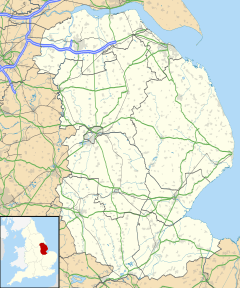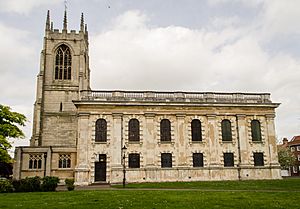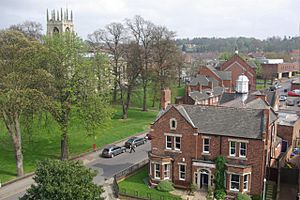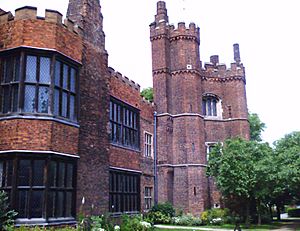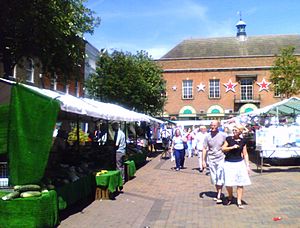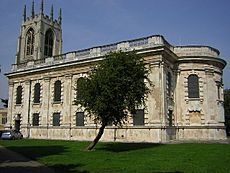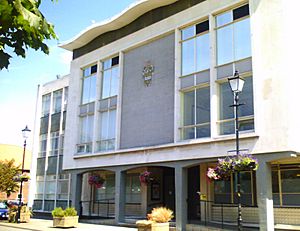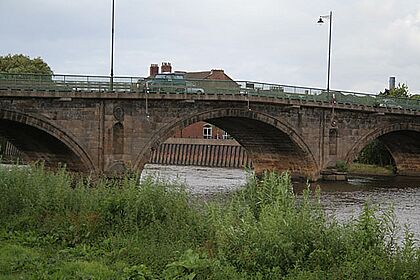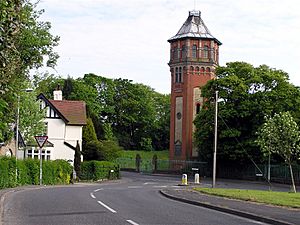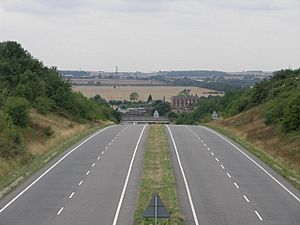Gainsborough, Lincolnshire facts for kids
Quick facts for kids Gainsborough |
|
|---|---|
| Town and civil parish | |
|
Clockwise from top: Gainsborough Skyline, All Saints Church, River Trent from Gainsborough Bridge, Old Town Hall and Old Hall |
|
| Population | 20,537 (2021 Census) |
| OS grid reference | SK815901 |
| • London | 135 mi (217 km) S |
| District |
|
| Shire county | |
| Region | |
| Country | England |
| Sovereign state | United Kingdom |
| Post town | GAINSBOROUGH |
| Postcode district | DN21 |
| Dialling code | 01427 |
| Police | Lincolnshire |
| Fire | Lincolnshire |
| Ambulance | East Midlands |
| EU Parliament | East Midlands |
| UK Parliament |
|
Gainsborough (/ˈɡeɪnzbərə/) is a market town and civil parish in the West Lindsey area of Lincolnshire, England. In 2011, about 20,842 people lived here. By 2019, this number grew to an estimated 23,243.
The town sits on the east bank of the River Trent. It is about 18 miles (29 km) north-west of Lincoln. Gainsborough is sometimes called England's furthest-inland port.
Contents
- Gainsborough's Past: A Look Back
- Gainsborough's Location and Roads
- Gainsborough and The Mill on the Floss
- What Gainsborough Makes: Industry and Business
- Important Places in Gainsborough
- Getting Around Gainsborough
- Sports in Gainsborough
- Local Media
- Fun Things to Do in Gainsborough
- Learning in Gainsborough
- Famous People from Gainsborough
- Gainsborough Around the World
- Images for kids
- See also
Gainsborough's Past: A Look Back
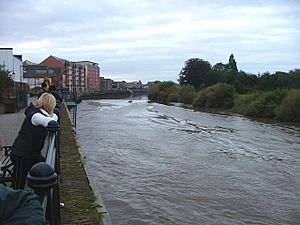
Kings and Vikings in Gainsborough
The name Gainsborough first appeared in old records in 1013. It means "Gegn's fortified place." It was an important town during the Anglo-Saxon period. The Vikings chose it as a key spot because it was close to their base in Torksey.
In 868, King Alfred married Ealhswith. She was the daughter of the chief of the Gaini people, which is where the town gets its name.
In July 1013, the Viking leader Sweyn Forkbeard and his son Cnut came to Gainsborough. They arrived with an army to conquer England. Sweyn defeated the English king, King Ethelred, who then left the country.
Sweyn became King of England and returned to Gainsborough. He and Cnut stayed at Gainsborough Castle, where the Old Hall is today. Sweyn died in Gainsborough about five weeks later. Some say he might have been killed.
Because of this, Gainsborough was the capital of England and Denmark for a short time in 1013. Cnut then moved his base elsewhere.
The Story of King Cnut and the Tide
You might have heard the story of King Cnut trying to stop the tide. Some historians think he might have done this at the River Trent in Gainsborough. He might have been showing his followers that even a king cannot control nature.
They believe he used the Trent Aegir, a special wave that comes up the river. Gainsborough was the furthest point this wave reached. However, this story was written down much later and might just be a fable.
Medieval Gainsborough Life
The Domesday Book from 1086 shows that Gainsborough was a farming community. It had farmers and other workers who rented land.
In 1204, King John allowed Gainsborough to have a weekly market. This helped the town grow.
Gainsborough Old Hall: A Royal Visit
Thomas Burgh bought the land in Gainsborough in 1455. He built Gainsborough Old Hall between 1460 and 1480. It is a large, old house made of timber, and it's one of the best-preserved manor houses in Britain.
The Old Hall has a grand Great Hall and a strong brick tower. Two famous kings, King Richard III in 1483 and King Henry VIII in 1541, both stayed there. The Hickman family bought the manor in 1596.
Gainsborough in the English Civil War
During the English Civil War in 1643, Gainsborough was held by the King's supporters. They worked with the army in Newark to attack the Parliamentarians.
Gainsborough was important because it was on a route around Newark. Parliament captured Gainsborough on July 20, 1643. But a large Royalist army quickly surrounded it, and the town had to surrender after three days.
Parliament took Gainsborough again in December 1643. But they had to leave in March 1644. They destroyed the town's defenses so the enemy couldn't use them.
After the war ended in 1645, some people in Gainsborough were fined for supporting the King. This included Sir Willoughby Hickman, who lived at the Old Hall.
Town Churches Through Time
The first church in Gainsborough was recorded in 1180. The old Church of All Saints became run down after the Civil War. In 1736, it was pulled down to build a new church. This new church, completed in 1748, mixed old Gothic and Classical styles.
Only the old west tower, 90 feet high, remains from the medieval church. All Saints' is still the main church in town.
As the town grew in the 1800s, more churches were built. Holy Trinity Church opened in 1843. St John the Divine Church opened in 1882, and St George's Church in the 1950s.
Many different Christian groups, called Non-conformists, also grew in Gainsborough. Some people believe that the Mayflower Pilgrims secretly met at the Old Hall before sailing to Holland in 1609. However, there is no clear proof of this.
The John Robinson Memorial Church was built in 1897. It was named after John Robinson, who was a pastor for the "Pilgrim Fathers" before they left on the Mayflower.
John Wesley, who started Methodism, preached in Gainsborough many times. The town's first Methodist chapel opened in 1788.
Gainsborough in World War II
Gainsborough had its only major air raid on May 10, 1941. Bombs were dropped, but many landed in the countryside. There was only minor damage and no one was hurt.
On April 28, 1942, a German plane dropped bombs on the town center. This caused a lot of damage and seven people died. Later, in December 1942, a Canadian training plane crashed, killing two airmen and a young girl.
On May 22, 1944, a British Spitfire plane crashed into a train, killing the pilot. On March 5, 1945, another German plane attacked the town. Three people died, and 50 houses were damaged.
Town Governance
Gainsborough Town Council was started in 1992. In the same year, Gainsborough got its first mayor.
Oil Discovery
In 1959, oil was discovered in Gainsborough. This was an important find for the area.
Gainsborough's Location and Roads
The town is where the A631 road crosses the River Trent on Trent Bridge. This is the only place to cross the river between two other major roads.
A road called Thorndike Way was built to help traffic. It is named after Dame Sybil Thorndike, a famous actress born nearby.
Gainsborough and The Mill on the Floss
Many experts believe that Gainsborough is the real-life place for the fictional town of St Ogg's in George Eliot's book The Mill on the Floss (1860). The writer visited Gainsborough in 1859. She stayed in a shipbuilder's house on Bridge Street.
The book mentions the stone bridge and a willow tree. The Old Hall is also described in detail. George Eliot might have seen the Trent Aegir (a special river wave), which could have inspired the flood in her story.
What Gainsborough Makes: Industry and Business
Boilers and Ironworks
Gainsborough has a long history of making things. It was home to Marshall, Sons & Co., a company that made boilers. William Marshall started it in 1848.
His company grew to be one of the biggest ironworks in Europe. Marshall's Works made steam engines that were sold all over the world. The company closed in the 1980s.
Packaging Inventions
Another important company was Rose Brothers. In 1893, William Rose invented the world's first packaging machine. The company grew and made many things, like machines for making seaside rock candy, cigarettes, and even slicing and wrapping bread.
Today, a company called Kerry Ingredients has a large mill by the River Trent.
Wigs, Jokes, and Exhausts
Gainsborough is home to two big companies that import jokes and novelties into the UK: Smiffy's and Pam's of Gainsborough. Smiffy's used to be the only wigmaker left in the UK.
Another local business is Eminox, started in 1978. They make large stainless steel exhaust systems for buses and trucks. They also build systems that help reduce pollution from vehicles.
Important Places in Gainsborough
The Whitton's Mill flats and Marshall's Yard have won awards for improving the town.
The West Lindsey District Council used to have its offices in the Guildhall. In 2008, they moved to a new building in Marshall's Yard.
Silver Street is a main shopping area in Gainsborough. Elswitha Hall is where Halford John Mackinder, a famous geographer, was born.
A water tower on Heapham Road was built in 1897. It marked Queen Victoria's 60 years as queen.
Getting Around Gainsborough
Trains
- Further information: Gainsborough Lea Road railway station and Gainsborough Central railway station
Gainsborough has two train stations. The main one is Gainsborough Lea Road. It has trains every hour to places like Lincoln, Sheffield, and Doncaster.
The other station is Gainsborough Central, closer to the town center. It has hourly trains to Sheffield on weekdays and Saturdays. On Saturdays, there are also three trains to Cleethorpes.
Buses
The town's bus station is on Hickmen Street. Buses run often from Monday to Saturday, but not on Sundays. Most local routes are run by Stagecoach.
There are buses every hour to Lincoln, Scunthorpe, and Retford. A bus to Doncaster runs every two hours.
Rivers and Trade

Gainsborough is sometimes called the most inland port in Britain. It is over 55 miles (89 km) from the North Sea. It has a long history of river trade.
There is still one wharf, but large ships no longer come this far up the river. Other wharves further down the river still handle commercial shipping.
Before 1787, there was a ferry across the Trent. The Trent Bridge was finished in 1791. It cost £12,000 to build. This bridge meant that taller river boats could not go further upstream. It used to be a toll bridge, meaning you had to pay to cross. But it became free on March 31, 1932.
Sports in Gainsborough
The town has a semi-professional football club called Gainsborough Trinity F.C.. They play in the Northern Premier League. For a short time in the early 1900s, the club was professional.
Gainsborough Rugby Club, also known as the All Blacks, has played Rugby Union since 1924.
The Gainsborough & Morton Striders Athletic Club was started in 1983. In 2013, they won an award as a top running group in England.
There are also several cycling clubs in the town.
Local Media
You can get TV signals from Belmont or Emley Moor transmitters. Local radio stations include BBC Radio Lincolnshire and Trentside Radio. The town's local newspapers are the Gainsborough Standard and Lincolnshire Echo.
Fun Things to Do in Gainsborough
Richmond Park, in the north of town, opened as a public park in 1947. It has greenhouses, an aviary (bird house), and a very old oak tree.
The Gainsborough Model Railway Society has one of the largest model railways. It shows the East Coast Main Line from Kings Cross to Leeds Central. This model railway started in 1953 and covers a huge area.
Gainsborough Old Hall is over 500 years old. It is one of the best-preserved medieval manor houses in England.
Gainsborough Town Hall, built in 1892, is now a place for shows and events.
The town's river banks were improved in 2002. This made it easier to walk along the river. The town used to host the Gainsborough Riverside Festival, an arts and heritage event, until 2013.
The Trinity Art Centre has live music, plays, comedy, and movies. There is also the Gainsborough Heritage Centre, run by volunteers. It shows many objects from the town's past.
Learning in Gainsborough
Lincolnshire has a special school system. For many students, secondary education is decided by an exam at age eleven. Gainsborough has a top state school called Queen Elizabeth's High School. It is a selective school for students aged 11 to 18.
Students at Queen Elizabeth's High School get excellent exam results. The school is very popular. The town also has several primary schools for younger children.
For older students, there are links to colleges in Scunthorpe and Lincoln. Lincoln College has a branch in Gainsborough that focuses on job-related training.
Famous People from Gainsborough
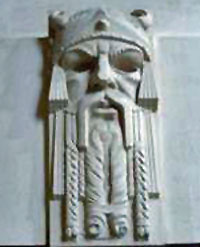
Many notable people have connections to Gainsborough:
- Sweyn Forkbeard (died 1014), a King of Denmark and England, died in Gainsborough.
- Simon Patrick (1626–1707), a religious leader and Bishop.
- Thomas Miller (1807–1874), an author and poet.
- Sir Halford Mackinder (1861–1947), a geographer and explorer.
- Dame Sybil Thorndike (1882–1976), a famous actress.
- John Alderton (born 1940), an actor known for TV shows like Upstairs Downstairs.
- Chris Mosdell (born 1949), a lyricist who wrote songs for famous musicians.
Gainsborough Around the World
Gainsborough is twinned with Cham, Germany. This means they have a special friendly relationship.
Images for kids
-
The Aegir (tidal bore) on the Trent
-
River Trent in Gainsborough, 2009
-
Sweyn Forkbeard, king of Denmark and England, who died in Gainsborough in 1014
See also
 In Spanish: Gainsborough (Lincolnshire) para niños
In Spanish: Gainsborough (Lincolnshire) para niños







